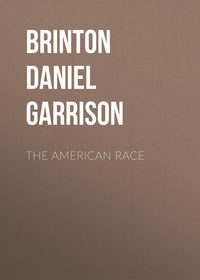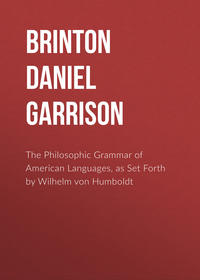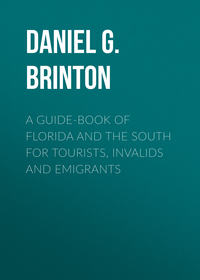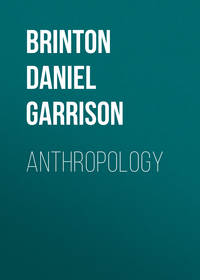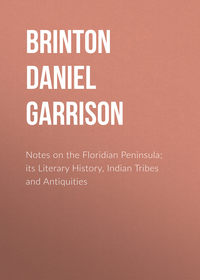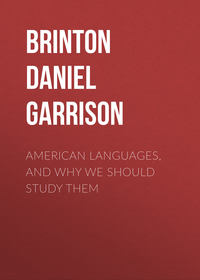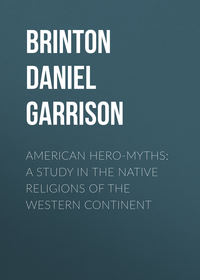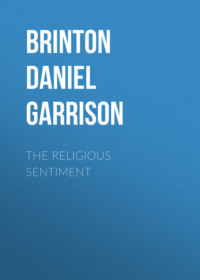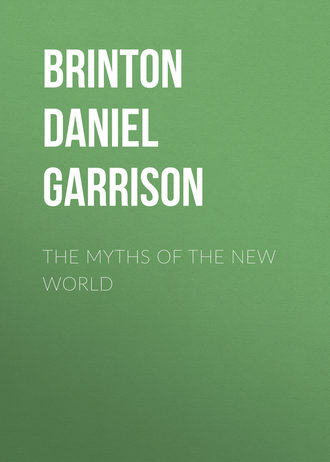 полная версия
полная версияThe Myths of the New World
Nothing can be more natural than to take into consideration the regions of the heavens in the construction of buildings; I presume that at any time no one plans an edifice of pretensions without doing so. Yet this is one of those apparently trifling transactions which in their origin and applications have exerted a controlling influence on the history of the human race.
When we reflect how indissolubly the mind of the primitive man is welded to his superstitions, it were incredible that his social life and his architecture could thus be as it were in subjection to one idea, and his rites and myths escape its sway. As one might expect, it reappears in these latter more vividly than anywhere else. If there is one formula more frequently mentioned by travellers than another as an indispensable preliminary to all serious business, it is that of smoking, and the prescribed and traditional rule was that the first puff should be to the sky, and then one to each of the corners of the earth, or the cardinal points.75 These were the spirits who made and governed the earth, and under whatever difference of guise the uncultivated fancy portrayed them, they were the leading figures in the tales and ceremonies of nearly every tribe of the red race. These were the divine powers summoned by the Chipeway magicians when initiating neophytes into the mysteries of the meda craft. They were asked to a lodge of four poles, to four stones that lay before its fire, there to remain four days, and attend four feasts. At every step of the proceeding this number or its multiples were repeated.76 With their neighbors the Dakotas the number was also distinctly sacred; it was intimately inwoven in all their tales concerning the wakan power and the spirits of the air, and their religious rites. The artist Catlin has given a vivid description of the great annual festival of the Mandans, a Dakota tribe, and brings forward with emphasis the ceaseless reiteration of this number from first to last.77 He did not detect its origin in the veneration of the cardinal points, but the information that has since been furnished of the myths of this stock leaves no doubt that such was the case.78
Proximity of place had no part in this similarity of rite. In the grand commemorative festival of the Creeks called the Busk, which wiped out the memory of all crimes but murder, which reconciled the proscribed criminal to his nation and atoned for his guilt, when the new fire was kindled and the green corn served up, every dance, every invocation, every ceremony, was shaped and ruled by the application of the number four and its multiples in every imaginable relation. So it was at that solemn probation which the youth must undergo to prove himself worthy of the dignities of manhood and to ascertain his guardian spirit; here again his fasts, his seclusions, his trials, were all laid down in fourfold arrangement.79
Not alone among these barbarous tribes were the cardinal points thus the foundation of the most solemn mysteries of religion. An excellent authority relates that the Aztecs of Micla, in Guatemala, celebrated their chief festival four times a year, and that four priests solemnized its rites. They commenced by invoking and offering incense to the sky and the four cardinal points; they conducted the human victim four times around the temple, then tore out his heart, and catching the blood in four vases scattered it in the same directions.80 So also the Peruvians had four principal festivals annually, and at every new moon one of four days’ duration. In fact the repetition of the number in all their religious ceremonies is so prominent that it has been a subject of comment by historians. They have attributed it to the knowledge of the solstices and equinoxes, but assuredly it is of more ancient date than this. The same explanation has been offered for its recurrence among the Nahuas of Mexico, whose whole lives were subjected to its operation. At birth the mother was held unclean for four days, a fire was kindled and kept burning for a like length of time, at the baptism of the child an arrow was shot to each of the cardinal points. Their prayers were offered four times a day, the greatest festivals were every fourth year, and their offerings of blood were to the four points of the compass. At death food was placed on the grave, as among the Eskimos, Creeks, and Algonkins, for four days (for all these nations supposed that the journey to the land of souls was accomplished in that time), and mourning for the dead was for four months or four years.81
It were fatiguing and unnecessary to extend the catalogue much further. Yet it is not nearly exhausted. From tribes of both continents and all stages of culture, the Muyscas of Columbia and the Natchez of Louisiana, the Quichés of Guatemala and the Caribs of the Orinoko, instance after instance might be marshalled to illustrate how universally a sacred character was attached to this number, and how uniformly it is traceable to a veneration of the cardinal points. It is sufficient that it be displayed in some of its more unusual applications.
It is well known that the calendar common to the Aztecs and Mayas divides the month into four weeks, each containing a like number of secular days; that their indiction is divided into four periods; and that they believed the world had passed through four cycles. It has not been sufficiently emphasized that in many of the picture writings these days of the week are placed respectively north, south, east, and west, and that in the Maya language the quarters of the indiction still bear the names of the cardinal points, hinting the reason of their adoption.82 This cannot be fortuitous. Again, the division of the year into four seasons—a division as devoid of foundation in nature as that of the ancient Aryans into three, and unknown among many tribes, yet obtained in very early times among Algonkins, Cherokees, Choctaws, Creeks, Aztecs, Muyscas, Peruvians, and Araucanians. They were supposed to be produced by the unending struggles and varying fortunes of the four aerial giants who rule the winds.
We must seek in mythology the key to the monotonous repetition and the sanctity of this number; and furthermore, we must seek it in those natural modes of expression of the religious sentiment which are above the power of blood or circumstance to control. One of these modes, we have seen, was that which led to the identification of the divinity with the wind, and this it is that solves the enigma in the present instance. Universally the spirits of the cardinal points were imagined to be in the winds that blew from them. The names of these directions and of the corresponding winds are often the same, and when not, there exists an intimate connection between them. For example, take the languages of the Mayas, Huastecas, and Moscos of Central America; in all of them the word for north is synonymous with north wind, and so on for the other three points of the compass. Or again, that of the Dakotas, and the word tate-ouye-toba, translated “the four quarters of the heavens,” means literally, “whence the four winds come.”83 It were not difficult to extend the list; but illustrations are all that is required. Let it be remembered how closely the motions of the air are associated in thought and language with the operations of the soul and the idea of God; let it further be considered what support this association receives from the power of the winds on the weather, bringing as they do the lightning and the storm, the zephyr that cools the brow, and the tornado that levels the forest; how they summon the rain to fertilize the seed and refresh the shrivelled leaves; how they aid the hunter to stalk the game, and usher in the varying seasons; how, indeed, in a hundred ways, they intimately concern his comfort and his life; and it will not seem strange that they almost occupied the place of all other gods in the mind of the child of nature. Especially as those who gave or withheld the rains were they objects of his anxious solicitation. “Ye who dwell at the four corners of the earth—at the north, at the south, at the east, and at the west,” commenced the Aztec prayer to the Tlalocs, gods of the showers.84 For they, as it were, hold the food, the life of man in their power, garnered up on high, to grant or deny, as they see fit. It was from them that the prophet of old was directed to call back the spirits of the dead to the dry bones of the valley. “Prophesy unto the wind, prophesy, son of man, and say to the wind, thus saith the Lord God, come forth from the four winds, O breath, and breathe upon these slain, that they may live.” (Ezek. xxxvii. 9.)
In the same spirit the priests of the Eskimos prayed to Sillam Innua, the Owner of the Winds, as the highest existence; the abode of the dead they called Sillam Aipane, the House of the Winds; and in their incantations, when they would summon a new soul to the sick, or order back to its home some troublesome spirit, their invocations were ever addressed to the winds from the cardinal points—to Pauna the East and Sauna the West, to Kauna the South and Auna the North.85
As the rain-bringers, as the life-givers, it were no far-fetched metaphor to call them the fathers of our race. Hardly a nation on the continent but seems to have had some vague tradition of an origin from four brothers, to have at some time been led by four leaders or princes, or in some manner to have connected the appearance and action of four important personages with its earliest traditional history. Sometimes the myth defines clearly these fabled characters as the spirits of the winds, sometimes it clothes them in uncouth, grotesque metaphors, sometimes again it so weaves them into actual history that we are at a loss where to draw the line that divides fiction from truth.
I shall attempt to follow step by step the growth of this myth from its simplest expression, where the transparent drapery makes no pretence to conceal its true meaning, through the ever more elaborate narratives, the more strongly marked personifications of more cultivated nations, until it assumes the outlines of, and has palmed itself upon the world as actual history.
This simplest form is that which alone appears among the Algonkins and Dakotas. They both traced their lives back to four ancestors, personages concerned in various ways with the first things of time, not rightly distinguished as men or gods, but very positively identified with the four winds. Whether from one or all of these the world was peopled, whether by process of generation or some other more obscure way, the old people had not said, or saying, had not agreed.86
It is a shade more complex when we come to the Creeks. They told of four men who came from the four corners of the earth, who brought them the sacred fire, and pointed out the seven sacred plants. They were called the Hi-you-yul-gee. Having rendered them this service, the kindly visitors disappeared in a cloud, returning whence they came. When another and more ancient legend informs us that the Creeks were at first divided into four clans, and alleged a descent from four female ancestors, it will hardly be venturing too far to recognize in these four ancestors the four friendly patrons from the cardinal points.87
The ancient inhabitants of Haiti, when first discovered by the Spaniards, had a similar genealogical story, which Peter Martyr relates with various excuses for its silliness and exclamations at its absurdity. Perhaps the fault lay less in its lack of meaning than in his want of insight. It was to the effect that men lived in caves, and were destroyed by the parching rays of the sun, and were destitute of means to prolong their race, until they caught and subjected to their use four women who were swift of foot and slippery as eels. These were the mothers of the race of men. Or again, it was said that a certain king had a huge gourd which contained all the waters of the earth; four brothers, who coming into the world at one birth had cost their mother her life, ventured to the gourd to fish, picked it up, but frightened by the old king’s approach, dropped it on the ground, broke it into fragments, and scattered the waters over the earth, forming the seas, lakes, and rivers, as they now are. These brothers in time became the fathers of a nation, and to them they traced their lineage.88 With the previous examples before our eyes, it asks no vivid fancy to see in these quaternions once more the four winds, the bringers of rain, so swift and so slippery.
The Navajos are a rude tribe north of Mexico. Yet even they have an allegory to the effect that when the first man came up from the ground under the figure of the moth-worm, the four spirits of the cardinal points were already there, and hailed him with the exclamation, “Lo, he is of our race.”89 It is a poor and feeble effort to tell the same old story.
The Haitians were probably relatives of the Mayas of Yucatan. Certainly the latter shared their ancestral legends, for in an ancient manuscript found by Mr. Stephens during his travels, it appears they looked back to four parents or leaders called the Tutul Xiu. But, indeed, this was a trait of all the civilized nations of Central America and Mexico. An author who would be very unwilling to admit any mythical interpretation of the coincidence, has adverted to it in tones of astonishment: “In all the Aztec and Toltec histories there are four characters who constantly reappear; either as priests or envoys of the gods, or of hidden and disguised majesty; or as guides and chieftains of tribes during their migrations; or as kings and rulers of monarchies after their foundation; and even to the time of the conquest, there are always four princes who compose the supreme government, whether in Guatemala, or in Mexico.”90 This fourfold division points not to a common history, but to a common nature. The ancient heroes and demigods, who, four in number, figure in all these antique traditions, were not men of flesh and blood, but the invisible currents of air who brought the fertilizing showers.
They corresponded to the four gods Bacab, who in the Yucatecan mythology were supposed to stand one at each corner of the world, supporting, like gigantic caryatides, the overhanging firmament. When at the general deluge all other gods and men were swallowed by the waters they alone escaped to people it anew. These four, known by the names of Kan, Muluc, Ix, and Cauac, represented respectively the east, north, west, and south, and as in Oriental symbolism, so here each quarter of the compass was distinguished by a color, the east by yellow, the south by red, the west by black, and the north by white. The names of these mysterious personages, employed somewhat as we do the Dominical letters, adjusted the calendar of the Mayas, and by their propitious or portentous combinations was arranged their system of judicial astrology. They were the gods of rain, and under the title Chac, the Red Ones, were the chief ministers of the highest power. As such they were represented in the religious ceremonies by four old men, constant attendants on the high priest in his official functions.91 In this most civilized branch of the red race, as everywhere else, we thus find four mythological characters prominent beyond all others, giving a peculiar physiognomy to the national legends, arts, and sciences, and in them once more we recognize by signs infallible, personifications of the four cardinal points and the four winds.
They rarely lose altogether their true character. The Quiché legends tell us that the four men who were first created by the Heart of Heaven, Hurakan, the Air in Motion, were infinitely keen of eye and swift of foot, that “they measured and saw all that exists at the four corners and the four angles of the sky and the earth;” that they did not fulfil the design of their maker “to bring forth and produce when the season of harvest was near,” until he blew into their eyes a cloud, “until their faces were obscured as when one breathes on a mirror.” Then he gave them as wives the four mothers of our species, whose names were Falling Water, Beautiful Water, Water of Serpents, and Water of Birds.92 Truly he who can see aught but a transparent myth in this recital, is a realist that would astonish Euhemerus himself.
There is in these Aztec legends a quaternion besides this of the first men, one that bears marks of a profound contemplation on the course of nature, one that answers to the former as the heavenly phase of the earthly conception. It is seen in the four personages, or perhaps we should say modes of action, that make up the one Supreme Cause of All, Hurakan, the breath, the wind, the Divine Spirit. They are He who creates, He who gives Form, He who gives Life, and He who reproduces.93 This acute and extraordinary analysis of the origin and laws of organic life, clothed under the ancient belief in the action of the winds, reveals a depth of thought for which we were hardly prepared, and is perhaps the single instance of anything like metaphysics among the red race. It is clearly visible in the earlier portions of the legends of the Quichés, and is the more surely of native origin as it has been quite lost on both their translators.
Go where we will, the same story meets us. The empire of the Incas was attributed in the sacred chants of the Amautas, the priests assigned to take charge of the records, to four brothers and their wives. These mythical civilizers are said to have emerged from a cave called Pacari tampu, which may mean “the House of Subsistence,” reminding us of the four heroes who in Aztec legend set forth to people the world from Tonacatepec, the mountain of our subsistence; or again it may mean—for like many of these mythical names it seems to have been designedly chosen to bear a double construction—the Lodgings of the Dawn, recalling another Aztec legend which points for the birthplace of the race to Tula in the distant orient. The cave itself suggests to the classical reader that of Eolus, or may be paralleled with that in which the Iroquois fabled the winds were imprisoned by their lord.94 These brothers were of no common kin. Their voices could shake the earth and their hands heap up mountains. Like the thunder god, they stood on the hills and hurled their sling-stones to the four corners of the earth. When one was overpowered he fled upward to the heaven or was turned into stone, and it was by their aid and counsel that the savages who possessed the land renounced their barbarous habits and commenced to till the soil. There can be no doubt but that this in turn is but another transformation of the Protean myth we have so long pursued.95
There are traces of the same legend among many other tribes of the continent, but the trustworthy reports we have of them are too scanty to permit analysis. Enough that they are mentioned in a note, for it is every way likely that could we resolve their meaning they too would carry us back to the four winds.96
Let no one suppose, however, that this was the only myth of the origin of man. Far from it. It was but one of many, for, as I shall hereafter attempt to show, the laws that governed the formations of such myths not only allowed but enjoined great divergence of form. Equally far was it from being the only image which the inventive fancy hit upon to express the action of the winds as the rain bringers. They too were many, but may all be included in a twofold division, either as the winds were supposed to flow in from the corners of the earth or outward from its central point. Thus they are spoken of under such figures as four tortoises at the angles of the earthly plane who vomit forth the rains,97 or four gigantic caryatides who sustain the heavens and blow the winds from their capacious lungs,98 or more frequently as four rivers flowing from the broken calabash on high, as the Haitians, draining the waters of the primitive world,99 as four animals who bring from heaven the maize,100 as four messengers whom the god of air sends forth, or under a coarser trope as the spittle he ejects toward the cardinal points which is straightway transformed into wild rice, tobacco, and maize.101
Constantly from the palace of the lord of the world, seated on the high hill of heaven, blow four winds, pour four streams, refreshing and fecundating the earth. Therefore, in the myths of ancient Iran there is mention of a celestial fountain, Arduisur, the virgin daughter of Ormuzd, whence four all nourishing rivers roll their waves toward the cardinal points; therefore the Thibetans believe that on the sacred mountain Himavata grows the tree of life Zampu, from whose foot once more flow the waters of life in four streams to the four quarters of the world; and therefore it is that the same tale is told by the Chinese of the mountain Kouantun, by the Brahmins of Mount Meru, and by the Parsees of Mount Albors in the Caucasus.102 Each nation called their sacred mountain “the navel of the earth;” for not only was it the supposed centre of the habitable world, but through it, as the fœtus through the umbilical cord, the earth drew her increase. Beyond all other spots were they accounted fertile, scenes of joyous plaisance, of repose, and eternal youth; there rippled the waters of health, there blossomed the tree of life; they were fit trysting spots of gods and men. Hence came the tales of the terrestrial paradise, the rose garden of Feridun, the Eden gardens of the world. The name shows the origin, for paradise (in Sanscrit, para desa) means literally high land. There, in the unanimous opinion of the Orient, dwelt once in unalloyed delight the first of men; thence driven by untoward fate, no more anywhere could they find the path thither. Some thought that in the north among the fortunate Hyperboreans, others that in the mountains of the moon where dwelt the long lived Ethiopians, and others again that in the furthest east, underneath the dawn, was situate the seat of pristine happiness; but many were of opinion that somewhere in the western sea, beyond the pillars of Hercules and the waters of the Outer Ocean, lay the garden of the Hesperides, the Islands of the Blessed, the earthly Elysion.
It is not without design that I recall this early dream of the religious fancy. When Christopher Columbus, fired by the hope of discovering this terrestrial paradise, broke the enchantment of the cloudy sea and found a new world, it was but to light upon the same race of men, deluding themselves with the same hope of earthly joys, the same fiction of a long lost garden of their youth. They told him that still to the west, amid the mountains of Paria, was a spot whence flowed mighty streams over all lands, and which in sooth was the spot he sought;103 and when that baseless fabric had vanished, there still remained the fabled island of Boiuca, or Bimini, hundreds of leagues north of Hispaniola, whose glebe was watered by a fountain of such noble virtue as to restore youth and vigor to the worn out and the aged.104 This was no fiction of the natives to rid themselves of burdensome guests. Long before the white man approached their shores, families had started from Cuba, Yucatan, and Honduras in search of these renovating waters, and not returning, were supposed by their kindred to have been detained by the delights of that enchanted land, and to be revelling in its seductive joys, forgetful of former ties.105
Perhaps it was but another rendering of the same belief that pointed to the impenetrable forests of the Orinoko, the ancient homes of the Caribs and Arowacks, and there located the famous realm of El Dorado with its imperial capital Manoa, abounding in precious metals and all manner of gems, peopled by a happy race, and governed by an equitable ruler.
The Aztec priests never chanted more regretful dirges than when they sang of Tulan, the cradle of their race, where once it dwelt in peaceful indolent happiness, whose groves were filled with birds of sweet voices and gay plumage, whose generous soil brought forth spontaneously maize, cocoa, aromatic gums, and fragrant flowers. “Land of riches and plenty, where the gourds grow an arm’s length across, where an ear of corn is a load for a stout man, and its stalks are as high as trees; land where the cotton ripens of its own accord of all rich tints; land abounding with limpid emeralds, turquoises, gold, and silver.”106 This land was also called Tlalocan, from Tlaloc, the god of rain, who there had his dwelling place, and Tlapallan, the land of colors, or the red land, for the hues of the sky at sunrise floated over it. Its inhabitants were surnamed children of the air, or of Quetzalcoatl, and from its centre rose the holy mountain Tonacatepec, the mountain of our life or subsistence. Its supposed location was in the east, whence in that country blow the winds that bring mild rains, says Sahagun, and that missionary was himself asked, as coming from the east, whether his home was in Tlapallan; more definitely by some it was situated among the lofty peaks on the frontiers of Guatemala, and all the great rivers that water the earth were supposed to have their sources there.107 But here, as elsewhere, its site was not determined. “There is a Tulan,” says an ancient authority, “where the sun rises, and there is another in the land of shades, and another where the sun reposes, and thence came we; and still another where the sun reposes, and there dwells God.”108




